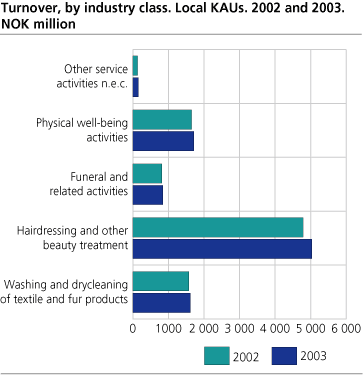Content
Published:
This is an archived release.
We spend more on personal well-being
In 2003, the average Norwegian spent more than NOK 1 100 on hairdressing and other beauty treatment. The industry had a total turnover of NOK 5 billion, up 5.2 per cent from NOK 4.8 billion in 2002.
If we look at spending on hairdressing and other beauty treatment by county, we see that people in Oslo had the highest spending with NOK 1 550 on average per person. The counties of Sør-Trøndelag and Rogaland also had an upward effect on the national average with average spending figures close to NOK 1 200. At the other end of the scale, the people of Aust-Agder, Finnmark, Nord-Trøndelag and Sogn og Fjordane counties spent an average NOK 900 on hairdressing and other beauty treatment.
The total number of local-kind-of-activity-units (KAUs) in the industry was 6 697 in 2003, more or less the same as in 2002. They employed 14 039 people in total, an increase of 0.9 per cent from 13 916 in 2002.
Physical well-being
The 1 034 local KAUs in the physical well-being industry had a turnover of NOK 1.7 billion in 2003, an increase of 3.8 per cent from 2002. Employment in the industry decreased by 6.2 per cent to 4 765 people in the same period.
Washing and dry-cleaning
The washing and dry-cleaning industry counted 382 local KAUs with a total turnover of NOK 1.6 billion in 2003, an increase of 2.7 per cent from 2002. The industry employed 2 812 people in 2003, down from 2 920 in 2002.
Tables:
- Table 1 Principal figures, by industry class. Local kind-of-activity units. 2002-2003
- Table 2 Hairdressing and other beauty treatment. Principal figures by county. 2002-2003
- Table 3 Physical well-beeing activities. Principal figures by county. 2002-2003
- Table 4 Hairdressing and other beauty treatment. Turnover per inhabitant, by county. 2003
The statistics is now published as Business statistics.
Additional information
Preliminary figures have fewer variables than final figures and are only published at enterprise level.
Contact
-
Statistics Norway's Information Centre
E-mail: informasjon@ssb.no
tel.: (+47) 21 09 46 42

